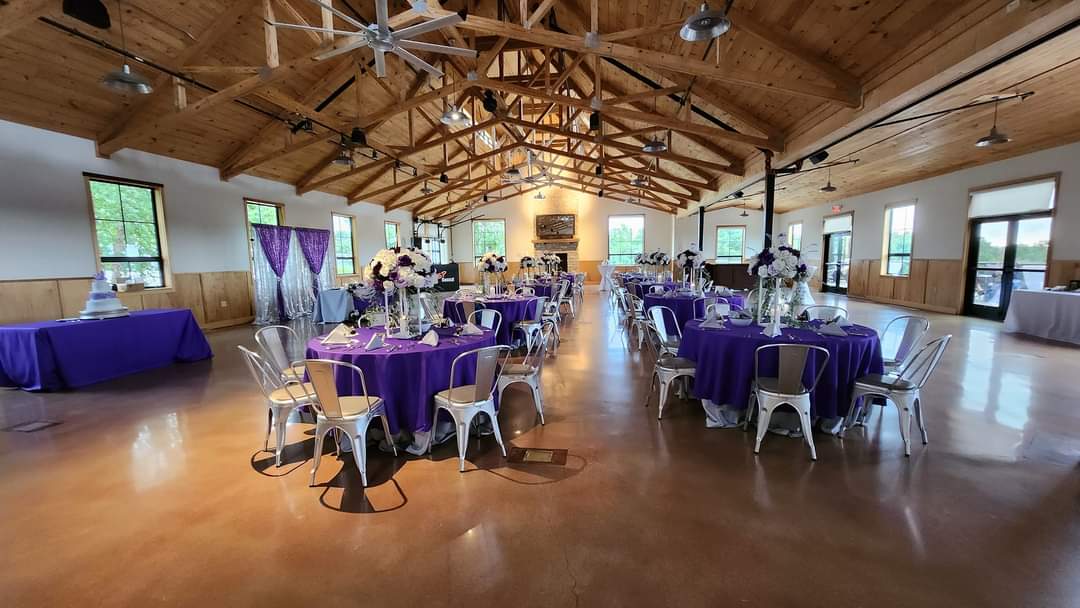Thank You Cards
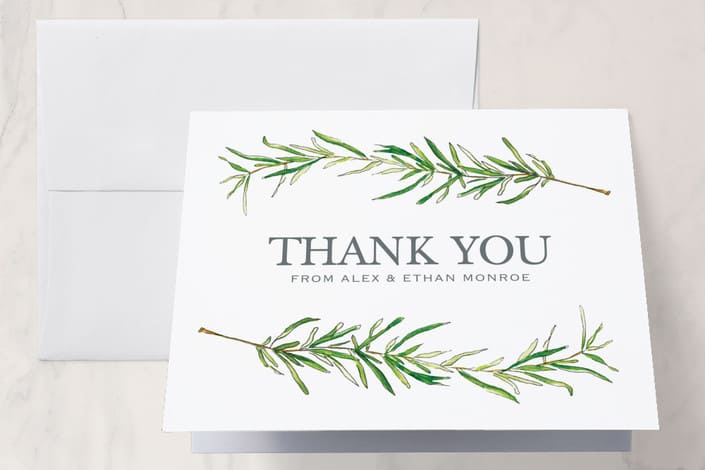
Finding time to write thank-you notes for wedding presents may seem overwhelming, but a few simple dos and don’ts will help keep you on track:
- Do personalize your notes and refer to the person as well as the gift.
- Do remember that a gift should be acknowledged with the same courtesy and generous spirit in which it was given.
- Do be enthusiastic, but don’t gush. Avoid saying a gift is the most beautiful thing you have ever seen unless you really mean it.
- Don’t send form letters or cards with printed messages and just your signature; don’t use email or post a generic thank you on your wedding web site in lieu of a personal note.
- Do promptly acknowledge the receipt of shipped gifts by sending a note right away or calling and following up with a written note in a day or two.
- Don’t mention that you plan to return a gift or that you are dissatisfied in any way.
- Don’t tailor your note to the perceived value of the gift; no one should receive a perfunctory note.
- Do refer to the way you will use a gift of money. Mentioning the amount is optional.
- Don’t include wedding photos or use photo cards if it will delay sending the note.
- Don’t use being late as an excuse not to write. Even if you are still sending notes after your first anniversary, keep writing!
Stationary For Your Wedding
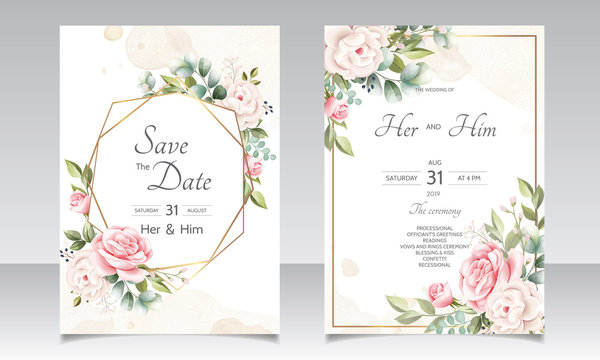
When is the appropriate time to start using stationery monogrammed with your new name? After you are married! You have so much going on before and during the wedding planning, there is no need to stress over stationery that you are going to use until the honeymoon is completed. Then, by all means, get the stationery out and start with those Thank You notes.
There is no single stationery that is required for a thank you note but there is something about a card/letter that has matching envelopes. The paper can be plain or printed, white, black or the color that matches your wedding theme. Whatever color or design that you choose, make sure that the writing is easy to read. Black is always a good choice.
A bride should use her pre-married name when sending monogrammed stationery before the wedding. This
A bride signs with her maiden name (or pre-marriage name, if an encore bride) before the wedding, and signs her married name afterward. When using monogrammed stationery, the notes sent by the bride before the wedding have her maiden name initials; post-wedding notes have her married initials or the couple’s last-name initial.
Grooms can write thank-you notes, too! When husbands and wives share monogrammed stationery, the last/married name initial, hyphenated initials, or double last-name initials (when the wife keeps her maiden name) are used.
Officiants
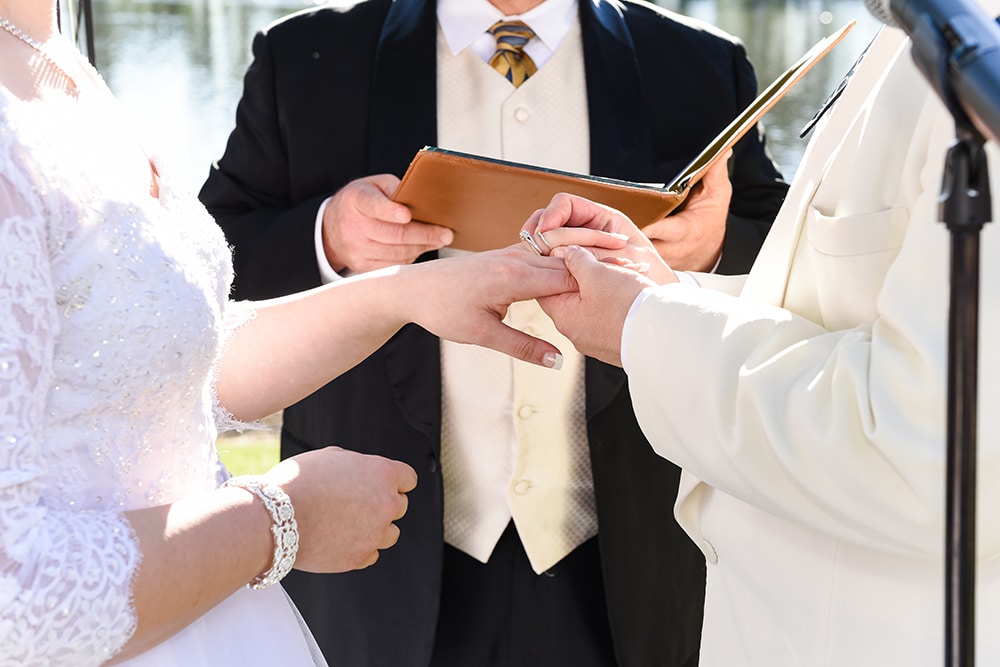
It’s important that you express gratitude to the wedding officiant who made your special day possible. Writing a personal, handwritten note to the wedding officiant is a fitting gesture of gratitude. You should also pay the officiant an appropriate fee for their services.
The officiant’s fee varies based on your relationship and the house of worship, local customs, and how much time he or she spends working with you before the wedding. If you have little contact with the officiant beforehand, the cost might be as low as $100; in other situations, especially those in which he or she has met with you several times about the ceremony, the fee can be as high as $500. You could call the church or synagogue with whom your officiant is affiliated and ask the secretary what is commonly offered or if the cost is pre-set. Once you know the appropriate fee, present it on your wedding day in a sealed envelope along with a handwritten note of thanks from you and your new spouse.
Gifts
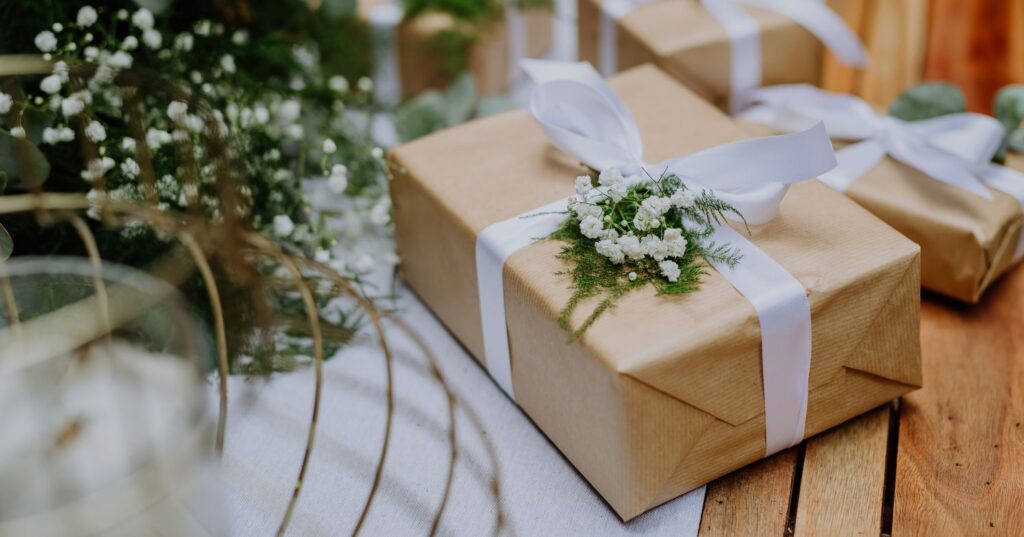
Although it seems odd that there is a “prohibition” against asking people not to bring you gifts when all you are trying to do is be thoughtful, there is a reason. The moment you mention gifts, you put an emphasis on gifts, which is the opposite of your intent. This is true whether this is your first wedding or an encore wedding.
Friends and family who have attended a first wedding and given a gift are under no obligation to give another wedding gift to the same person, even if (as is usually the case) the new marriage is to a different person. There will be many who are happy to know this but who will want to give you a gift anyway, to share in the celebration of your happiness.
The best way to assure them that you don’t need a thing, but care deeply about their presence, is to tell them. You can also solicit the help of your attendants, parents, siblings, and other close friends by asking them to pass this message along to anyone who asks them what you would like.
New friends who have never given you a wedding gift before may want to give you something. For them, it is helpful either if you register at a few stores for the fun things that you don’t have or make a list for your parents and attendants to share, if asked.
Your ideas could be anything from a new monogrammed towels and sheets to a bunch of movie tickets and a popcorn gift certificate for a nearby theater, to a welcome mat for your front door. You can keep your ideas to reasonably priced items that would be fun for your friends to find or create to commemorate your marriage.
Family & Children

There are those parents who go right ahead and write their children’s names on the response card, some doing it intentionally, believing they ought to have been invited in the first place (untrue); others truly believe the children are included. Whoever is hosting the wedding may call immediately and explain in kind terms that the children are indeed not invited. Give the benefit of the doubt, and keep the focus on who is invited, “I’m sorry if there was any confusion, but the invitation was only for you and Henry. We hope you can still attend.” Stay strong but kind if they push; making an exception won’t be fair to other guests who respected your wishes and found childcare. If this results in an angry, “then I’m not coming either,” so be it. The breach of etiquette is theirs, not yours.
Inviting an ex-spouse to your wedding really depends on the relationship that you have with them. Many times, with co-parenting, the former spouses have become more of friends and may choose to allow the ex-spouse to attend on behalf of the children. Make sure that you have these conversations with not only your children, but with your future spouse as well. If you know that there might be drama, or any ill feelings, it is best to not invite the ex-spouse to the ceremony or reception. Be firm but realistic.
Wedding Invitations

Do:
- Do allow plenty of time. Plan enough time in your schedule to carefully address, assemble, and mail your invitations.
- Do get organized. Develop a system for addressing and mailing your invitations. Prepare by gathering the names and addresses of everyone on your guest list. Arrange each piece that goes into an invitation in a stack, in the order it will be picked up, assembled, and inserted into the envelope.
- Do ask for help. Invite friends, family or bridal attendants to help assemble invitations.
- Do use the names of all “and guests” when possible. It is much warmer and more welcoming to use the correct names of those who will accompany your guests on invitations instead of “and guest.”
- Do use correct titles. It’s flattering when invitations are addressed correctly. This means using appropriate titles and spelling names correctly. When in doubt, ask before addressing.
Don’t:
- Don’t forget to include any appropriate inserts, such as maps, directions or hotel information for out-of-town guests.
- Don’t include registry or gift information with your invitation. It is in poor taste to insert a list of places where the bride and groom are registered or a checklist of the things they want and don’t want.
- Don’t use a standby guest list. When possible, invite your entire guest list at the same time rather than waiting to see how many people accept before sending out a second round of invitations. When the guest list is carefully planned, and when you consider the likelihood that 10-20 percent of invited guests typically send regrets, this approach is much more straightforward than using a standby list.
- Don’t use address labels for wedding invitations. Always address wedding invitation envelopes by hand, even when inviting hundreds of guests.
Addressing Wedding Invitations
Opening a wedding invitation is unlike opening any other piece of mail. Much care goes into addressing both the inner and outer envelopes. Several enclosures usually accompany the invitation itself, and there is a thoughtful order to how they are placed inside the outer envelope, and even a few things to think about when you stamp and mail them.
Before You Begin
- Allow plenty of time to address, assemble, and mail all invitations.
- Order extra envelopes—inner and outer—in case of errors.
- Consider the reply address you will wish to use. Guest responses and gifts are likely to be sent to the return address on the outer envelope. If guests should reply to a different address, use it for the reply card envelope or list it below the RSVP line on the invitation.
- Organize the master guest list in a useful form, such as on file cards, in a computer database, or on a spreadsheet.
- Extra tip: When response cards are used, lightly mark the back of each card with an identifying number (keep track on your master guest list) in case guests neglect to write in their names when RSVPing.
- Make sure your addressing and/or assembly area is clean (be careful with beverages!) and wash your hands before you begin.
How to Address the Envelopes
- Double check the spelling of your guests’ names before addressing the envelopes.
- Invitations are always addressed to both members of a married couple.
How to Address the Inner Envelope of a Wedding Invitation
The inner envelope bears the title and last names of the specific people invited. This allows the host to be very clear about who is invited, and by omission, who is not invited.
If children are invited but are not receiving a separate invitation, their names may be written on a line below their parents’ names on the inner envelope. If no inner envelope is used, children’s names are written on the outer envelope below the names of their parents.
For example, the inner envelope for Mr. and Mrs. James Darling and the two Darling children, Sarah and Jonathan, would be written:
Mr. and Mrs. Darling
Sarah Darling
Jonathan Darling
It’s also fine to write familiar names for close family: Aunt Martha and Uncle Bill.
How to Address the Outer Envelope of a Wedding Invitation
The outer envelope is addressed conventionally using titles, first, (middle), and last names.
- An invitation to an unmarried couple residing at the same address is addressed with both names connected by “and.” Use one or two lines, depending on length.
- No abbreviations or middle initials are used when addressing formal invitations.
While titles are abbreviated (Mr., Mrs., Ms., Dr.) all other words such as “Street,” or “Boulevard” are spelled out. State names may be written in full or use the two-letter postal code abbreviation. Middle initials aren’t used, so either write out the middle name or omit it. Generally, an invitation to parents and children is addressed to the parents:
Mr. and Mrs. James Arthur Darling
Forms of Address
Following is list of the most common forms of address. Please see our Guide to Addressing Correspondence for a complete list.
To a married couple:
Invitations are always addressed to both members of a married couple, even though the bride may know only one or knows that only one will attend.
To an unmarried couple living together:
Invitations to an established couple who are unmarried but live at the same address are addressed to “Ms. Nancy Fellows and Mr. Scott Dunn,” on one line.
To a married woman doctor or two married doctors:
If the woman uses her husband’s name socially, the address is “Dr. Barbara and Mr. James Werner.” If she uses her maiden name both professionally and socially, it is “Dr. Barbara Hanson and Mr. James Werner.” If the husband is also a doctor, the address is either “The Drs. Werner” or “Drs. Barbara and Robert Werner.”
How to add “and Guest”:
Since it’s awkward and impersonal to address the outer envelope as “Mr. James Smith and Guest,” the two-envelope system works well. Address the outer envelope to “Mr. James Smith” and the inner envelope to “Mr. James Smith and Guest.” If you’re only using one envelope, include a short note with your invitation: “Dear James, you’re welcome to bring a guest to the wedding. Please let me know. Best, Laura.” If there’s time and James supplies the information, you can send his guest an invitation, too.
How to Stuff the Envelopes:
- When two envelopes (inner and outer) are used, insert the invitation (folded edge first for a folded invitation, left edge for a single card invitation), so that you see the printed side of the invitation when the envelope flap is opened.
- When there are enclosures—reply card and envelope, map, printed directions, etc.—they are placed on top of the printed side of the invitation, with their printed sides up, in size order with the smallest on top. Again, when the flap is opened, the printed side should be visible. If the invitation is folded, insertions are stacked in size order—smallest on top—but within the fold. Tissues are optional. If used, they are placed on top of the invitation and below any enclosures. If the invitation is folded, they are inserted into the fold.
- The inner envelope is then placed unsealed in the outer envelope, so when the outer envelope flap is lifted, the name(s) of the guest(s) is visible.
- Before sealing the outer envelope, double- and triple-check that the names on the inner and outer envelopes match up.
Mailing Wedding Invitations
Before you buy stamps, take an assembled invitation to the post office, and have it weighed. It’s likely that the inserts, or even an unusually shaped envelope, will call for extra postage. The post office usually has wedding-themed stamps that will cover the cost of most invitations with enclosures. Some post offices may be out of stock, however, so leave time to find them at another branch or to order them online.
Remember that maps and other inserts sent to out-of-town guests will make those invitations heavier than ones sent to local guests and may require a postage adjustment. In that case, be sure to assemble two sets and have both weighed.
Lastly, ask at your post office if it is possible to have your envelopes hand stamped. This produces a different postmark (often considered more attractive) than if your invitations were run through an automatic sorter.
Personal Grooming
Women:
In general, personal grooming should be done in private. But putting on lipstick without using a mirror and without fanfare is one grooming ritual that can sometimes be performed in front of others. It’s okay to quickly apply lipstick at the table if you’re with close friends or relatives in a non-business situation, and at a non-deluxe restaurant. Skip anything that involves the use of wands, pencils, or lipstick brushes, though. And when in doubt, don’t do it, such as when you’re at a business meal or with people you don’t know very well.
Men:
Many men don’t like to think too hard about ties: but they should. Next to shoes and watches, ties are the most visible of the very few accessories that men wear. Ties that are good quality and suit your personality, proportion and skin tone help to establish your professional image. Whether your style is elegant, creative, or classic, these tips should help:
Quality
- Look for ties that are good quality silk (best choice: 100% silk) and muslin lined.
- Silk is very durable and holds color well, so it can withstand years of dry cleaning.
- Quality lining helps a tie retain its shape over time.
Fit
- The end of the tie should come to the middle or bottom of the waistband of your pants.
- Ties should hang straight (no buckling).
Knots
- The Four-in-hand is one of the most popular knots because of its simplicity.
- The Half-Windsor is also very popular (a medium triangular knot).
- The Windsor is a wider triangle and best for cut-away (wider spaced) collars—it is also considered more formal.
Proportions
- If you’re tall and thin, try ties with diagonal stripes, which help to visually widen. You can do a wider knot (example: Windsor) to take up more visual space.
- If you’re on the shorter side, the knot should be small (example: Half-Windsor).
- If you are heavy-set or on the large/athletic side, ties should be proportional to your size (example: Choose a wider tie versus a skinnier tie).
- If you are large or “fashion forward,” you are more likely able to wear a large, patterned tie.
- Default to a more traditional look if your office environment is more conservative.
Skin tone
- Men with warm skin tones (ivory, peach, caramel, copper, or golden undertones) look great in warm or yellow-based colors.
- Your best tie colors are scarlet, orange-red, coral, olive green, lime, ginger, bronze, chestnut.
- Men with cool skin tones (pink, violet or blue tones in your skin,) look great in blue-based colors. Your best tie colors are burgundy, blue, red, pink, teal, forest green, white accents, light and medium blue, navy, pink-brown (taupe), purple.
Toasting

There are few traditions as sacred as that of the toast. What may have started as a libation offering to the Gods became a tradition for honoring guests. Once upon a time, a host drank from the communal vessel to prove goodwill (and the absence of poison) before offering drink to a guest. Now we use the toast to formalize relationships and offer praise at the most elaborate of functions, but never underestimate or forget the power of the informal toast to convey that same honor and goodwill among friends and family gathered with much less formality.
Here are a few modern etiquette tips to help you toast like a pro:
How to Give a Modern Toast:
- Set the Stage: The contemporary toast may be offered by anyone for any purpose. A toast is a simple and gracious means of calling attention to shared gifts, whether it is thanking the cook for the meal, family members for attending, team members for hard work, or volunteers for effort. The venue can be a business lunch or a family gathering, but the elements of a simple informal toast remain the same and can be used to great effect.
- Fill Your Glass: While you might associate a toast with champagne, don’t be afraid to make each toast your own; fill your glasses with something as meaningful as what you plan to say. You can toast with whatever you prefer to drink. It is the message you deliver, not the beverage you consume, that gives the toast true meaning.
- Get People’s Attention: Stand, raise a glass or hold a meaningful silence long enough to be noticed. Resist the urge to bang on glassware with silver or clear your throat repeatedly. Don’t forget the power of your words, they are magic. “Excuse me, could I have your attention for just a moment? I’d like to propose a toast…”
Cell Phones & Texting

Cell phones are great—they keep us in touch with friends and family and can be life savers in an emergency. But they can also be annoying if not used thoughtfully. Your phone doesn’t have to be on all the time, and you don’t always have to answer it immediately. Learn to use your phone’s features like silent ring, vibrate and voice mail to handle the times when your phone would be bothering others if it rang, and you answered it. Here are tips for cell phone etiquette:
- Be in control of your phone, don’t let it control you!
- Speak softly.
- Be courteous to those you are with; turn off your phone if it will be interrupting a conversation or activity.
- Watch your language, especially when others can overhear you.
- Avoid talking about personal or confidential topics in a public place.
- If it must be on and it could bother others, use the “silent” mode, and move away to talk.
- Don’t use your camera to take pictures during the ceremony unless asked to do so. Most couples hire a professional photographer and your flash could offset the image they trying to capture.
- Don’t text during the wedding. Remember, you were invited for a reason!
- Private info can be forwarded, so don’t text it.
Parties & Events

Ways To Be A Good Host
No matter the type of party you’re throwing, here are some things a host should consider, even before the party starts:
- Invite clearly. Include necessary information for your guests in the invitation: the date, the time, the place, the occasion, the host(s) and when and how to respond “yes” or “no.” Add any special information such as what to wear or what to bring, say, for a potluck.
- Plan well. Take care creating your guest list. A great group of people will make any party a success, even if it rains on the picnic or the food is a flop. Get everything ready—your meal prepped, the table set, your party space tidy, refreshments ready—well before your guests arrive, so you’ll feel relaxed from the very beginning.
- Be welcoming and attentive. Make sure guests are greeted warmly, then made to feel welcome throughout the party. Look after each guest as much as you can. If you notice a guest with an empty glass or if there’s one person standing alone, act and remedy the situation.
- Be flexible and gracious. Problems will arise. A friend arrives with an unexpected guest. The ruined dessert? Have a fallback. The uninvited guest? As discourteous as it is for someone to spring a surprise on you, be gracious. No polite host would ever send an uninvited guest packing. Have a back-up plan for food that may get ruined during the cooking process.
- Be the leader and the spark. It’s your job to run the show and let your guests know when it’s time for dinner, or dessert, or charades. Circulate among your guests, introduce newcomers, and stay with each group long enough to get a conversation going.
- Be appreciative. Thank people for coming as you bid them good-bye. And don’t forget to thank anyone who brought you a gift.
Ways To Be A Good Guest
Good guests really shine and are welcome additions to any gathering. Here’s how:
- Tell your host whether you’re attending. And do it immediately. If you delay your reply, you could hinder the host’s planning and make it seem as if you’re waiting for something better to come along. Even if no RSVP has been requested, it’s thoughtful to thank your host for the invitation and let him know if you can be there or not.
- Be on time. Punctuality means different things to people in different locales. In general guests should arrive at or shortly after (fifteen minutes or less) the time stated on the invitation. Do not, however, arrive early unless asked to by the host. If you will be seriously late, call your host with an ETA so she won’t worry.
- Be a willing participant. When your host says that it’s time for dinner, go straight to the table. If you’re asked to participate in a party game, accept graciously and enthusiastically no matter how you really feel.
- Offer to help when you can. If you’re visiting with the host in the kitchen as he prepares the food, be specific when you offer to help: “I’d be happy to prepare the salad or fill the water glasses.” Even if your offer is refused, your gesture will be appreciated. At the party’s end, you could also offer to help with the cleanup.
- Don’t overindulge. Attacking finger foods as if you haven’t eaten in a week will not only attract the wrong kind of attention, but it will also leave less food for other guests. Same goes for the wine. Moderation is the name of the game.
- Thank your host twice. Always thank your hosts enthusiastically when you say your good-byes. A second thank you by phone the day after the party is also a gracious gesture. If the party was formal or given in your honor, written thanks are in order. In fact, a written note is always appreciated—even after casual parties.
Invitation Timelines
Whether you’re mailing invitations or inviting guests by phone or email, timing is key.
Send an invitation too late and the guest may already be booked; send it too early and it might be misplaced or forgotten. The following guidelines aren’t set in stone but will give you an idea of when to mail various types of invitations. Err on the early side if your event is important or the guest list is large.
| The Event | When to Invite |
| Anniversary party | 3 to 6 weeks |
| Bar or Bat Mitzvah | 1 month |
| Bon Voyage party | Last minute to 3 weeks |
| Casual party | Same day to 2 weeks |
| Charity Ball | 6 weeks to 3 months |
| Christmas party | 1 month |
| Cocktail party | 1 to 4 weeks |
| Debutante Ball | 6 weeks to 3 months |
| Formal dinner | 3 to 6 weeks |
| Graduation party | 3 weeks |
| Housewarming party | A few days to 3 weeks |
| Informal dinner | A few days to 3 weeks |
| Lunch or Tea | A few days to 2 weeks |
| Holiday dinner | 2 weeks to 2 months |
RSVP

It is inconsiderate, but unfortunately common, for guests to fail to RSVP.
Anyone who receives an invitation has an important obligation to reply as soon as possible. And yet so many don’t. Some forget; others procrastinate and then feel guilty, so they delay even longer. To many a host on the non-receiving end of an RSVP, it seems as if an invitee is simply waiting for something “better” to possibly come along. One of the sad parts about the demise of the RSVP is that relationships often suffer due to hosts’ resultant hurt feelings and frustration. It is perfectly polite, however, for hosts to call friends to ask if they plan to attend. In fact, if you want an accurate headcount, you have no choice but to call those who haven’t responded and ask whether they plan to come to your event or celebration.
